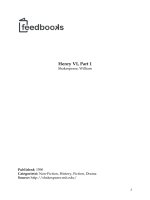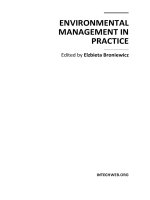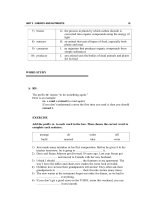Environmental studies part 1 pot
Bạn đang xem bản rút gọn của tài liệu. Xem và tải ngay bản đầy đủ của tài liệu tại đây (526.8 KB, 10 trang )
UNIVERSITY OF TECHNOLOGY
FOREIGN LANGUAGE DEPARTMENT
FOR
ENVIRONMENTAL STUDIES
FOR INTERNAL USE ONLY
UNIT 1 : EN
V
IRONMENT AND ECOLOGY 1
UNIT
1
ENVIRONMENT AND ECOLOGY
WARM-UP
1) What do you think the term environment refers
to?
2) What environmental issues are you concerned
about?
3) Have you ever heard of the word
ecology
?
READING
The term environment broadly indicates the surroundings of an
individual
organism or a community of organisms, ranging on up to the entire
biosphere,
the zone of Earth that is able to sustain life. By surroundings is meant all
the
nonliving and living materials that play any role in an organism's
existence,
from soil and air to what the organism feeds on and the organisms that
may
feed on it. Any other factors acting on the organism, such as heat and light
and
gravitation, make up its environment as well. In the case of human
beings,
cultural factors may also be included in the
term.
Figure
1
2 ENGLISH FOR ENVIRONMEN
T
A
L STUDIES
The environmental science of ecology is the study of the relationship of
plants
and
animals to their physical and biological environment. The
physical
environment includes
light and heat or solar radiation, moisture, wind,
oxygen,
carbon dioxide, nutrients in soil,
water, and atmosphere. The
biological
environment includes organisms of the same kind
as well as other plants
and animals.
Because of the diverse approaches required to study organisms in
their
environment,
ecology draws upon such fields as climatology,
hydrology,
oceanography, physics,
chemistry, geology, and soil analysis. To study
the
relationships between organisms,
ecology also involves such disparate
sciences
as animal behavior, taxonomy, physiology,
and
mathematics.
An increased public awareness of environmental problems has made ecology
a
common
but often misused word. It is confused with environmental
programs
and environmental
science. Although the field is a distinct scientific
discipline,
ecolo gy does
indeed contribute to the study and understanding
of
environmental
problems.
The term ecology was introduced by the German biologist Ernst
Heinrich
Haeckel in
1866; it is derived from the Greek oikos (“household”), sharing
the
same root word as
economics. Thus, the term implies the study of the
economy
of nature. Modern ecology,
in part, began with Charles Darwin. In
developing
his theory of evolution, Darwin
stressed the adaptation of organisms to
their
environment through natural selection.
Also making important
contributions
were plant geographers, such as Alexander von
Humboldt, who were
deeply
interested in the “how” and “why” of vegetational
distribution around
the world.
Figure 2 :
Eco
l
ogy
UNIT 1 : EN
V
IRONMENT AND ECOLOGY 3
READING COMPREHENSION
A.
QUESTIONS
Answer the questions about the
reading.
1) What is
environment?
2) Who is considered to be the founder of modern
ecology?
3) When was the term ecology used for the first
time?
4) What does ecology deal
with?
5) Why does ecology depend on such sciences as climatology,
oceanography,
physics, chemistry, or
geology?
B.
TRUE-FALSE
Write T if the sentence is true and F if it is
false.
1)
_
The term environment also includes cultural
factors.
2)
_
Ecology does not draw upon physiology or
mathematics.
3)
_
_
Ecology does not contribute to the study and understanding
of
environmental
problems
4)
_
Ecology is the study of the interactions of organisms with
their
5)
_
physical and biological
environment
The term ecology was introduced in the mid 19
th
century.
VOCABULARY
Choose the best word or phrase in the box for each of the
following
sentences.
discipline
biosphere
factors
sustain
contributions
environmental
organisms
selection
involves
evolution
1) Ecology focuses on the interactions taking place between
…………………
and their
environments.
2) The study of ecology also includes how the nonliving
………………………
in the environment influence one
another.
3) Darwin's theory of ……………………… was essentially
ecological.
4) When did ecology emerge as a distinct ……………………
?
5) Alexander von Humboldt made significant …………… to
ecology.
6) Ecology also ……………… such disparate sciences as animal
behavior,
taxonomy, physiology, and
mathematics
7) The moon can …………………… life because it does not provide enough
of
what organisms need in order to live or
exist.
4 ENGLISH FOR ENVIRONMEN
T
A
L STUDIES
8) Darwin stressed the adaptation of organisms to their environment
through
natural
……………………….
9) An ………………… movement aims to improve or protect the
natural
environment.
10) The ……………………… is the part of the earth’s surface and atmosphere
in
which plants and animals can
live.
WORD STUDY
A. UN-, IM-, IN-, DIS-, AND
NON-
The prefixes un-, im-, in-, dis-, and non- can be added to the beginning of
some
words. These prefixes mean
“not.”
Look at this
example:
un- + healthy =
unhealthy
Smoking is not good for you. It’s
unhealthy.
Here are other words with these negative
prefixes.
un- unimportant,
unpopular
im-
impossible
in- incomplete,
inexpensive
dis-
discontinue
non-
nonfat
EXERCISE
Choose the best word to complete each
sentence.
1) A person who is unfriendly is probably ………………,
too.
A. unpopular B. unusual C. uncomfortable D.
unimportant
2) The service at this restaurant is very slow. It’s ……………… to have a
quick
lunch
here!
A. impossible B. important C. immoral D.
immediate
3) The airline will ………… service to that city. It is not a popular place to
go.
A. discontinue B. disagree C. disable D.
discover
4) ……………… yogurt is better for you than ice
cream.
A. N on stop B. Nonfat C. Nonst and ard D.
Nonstick
5) Jaime’s homework is ……………… because he felt sick last
night.
A. inexpensive B. incomplete C. inflexible D.
inevitable
UNIT 1 : EN
V
IRONMENT AND ECOLOGY 5
B. ±MENT AND ±ER
Some nouns and verbs have the same form. We can add a special ending,
or
suffix, to other verbs to make noun
forms.
Here are some
examples:
same
form
-ment
-er
verb
noun
verb
noun
verb
noun
order
drink
cost
order
drink
cost
govern
agree
government
agreement
drive
own
run
work
driver
owner
runner
worker
EXERCISE
Complete the sentences with verbs and nouns from the chart. (If you need
to,
make the nouns plural. Also, make sure that each verb agrees with
its
subject.)
1) Susan is the fastest ……………… . She can ……………… the race in
less
than three
minutes.
2) The bus ……………… will not ……………… an unsafe
bus.
3) I think the two companies will ……………… to work together. They
will
both sign the
……………….
4) – Did Saul ……………… a salad and some
tea?
– Yes. Now he’s waiting for his ………………
.
5) Joseph bought a lot of food and ……………… for the get-together. He
hopes
that everyone will eat and ……………… a
lot.
6) Even though they……………… hard, most of the ……………… at
fast-food
restaurants do not make a lot of
money.
7) – My aunt is the ……………… of that popular take-out restaurant on
Main
Street.
– Does she ……………… the restaurant on Green Street,
too?
C. ±TH AND
±
GHT
Some nouns that end in ±th or ±ght are related to similar words that are
not
nouns. Read the following pairs of sentences and see how the words in bold
are
related.
1) Some cities grow quickly. Their growth is
fast.
2) The street is five kilometers long. The length is five
kilometers.
3) The street is fifteen meters wide. Its width is fifteen
meters.
4) The lake is thirty meters deep. Its depth is thirty
meters.
6 ENGLISH FOR ENVIRONMEN
T
A
L STUDIES
5) Joanna is very strong. She has a lot of
strength
.
6) How high is that building? What is its
height
?
7) Anna weighs 50 kilos. Her weight is 50
kilos.
EXERCISE
Now choose the best word for each sentence. Use each word only
once.
depth
height
strength
width
growth
length
weight
1) The flag is flying high above the ground. The …………………of
that
flagpole is about 20
meters.
2) The …………………of the Golden Gate Bridge in San Francisco is
about
1,400 meters. It is a very long
bridge.
3) What is the …………………of the Pacific Ocean at its deepest
point?
4) People who build houses must be very strong. They must have
great
…………………in their
arms.
5) Plants need a lot of water to grow. Without it, their …………………is
slow.
6) What is the …………………of your garage? Is it wide enough to park
two
cars
inside?
7) David is very thin now. He weighs only 49 kilos. He lost a lot
of
…………………
.
STRUCTURE STUDY
THE
PASSIVE
A sentence is often written in a passive form when the important idea is
not
WHO does something, but WHAT IS
DONE.
(a) They measured the extension in the steel
bar.
(b) The extension in the steel bar was
measured.
If the doer of the action has some importance (though less than the object), or
is
needed to complete the sense of the sentence, it is given, e.g. ‘A knowledge
of
statistics is required by every type of
scientists
.’
Passives can be formed in the following
ways:
a) A tense of be + past
participle
active: He coo ked th e
food.
passive: The food was
cooked.
UNIT 1 : EN
V
IRONMENT AND ECOLOGY 7
b) Modal + be / have been + past
participle
active: He m ay cook the
food.
passive: The food may be
cooked.
c) to be / to have been + past
participle
active: He is to cook the
food.
passive: The food is to be
cooked.
d) being / having been + past
participle
active
:
Cooking / Having cooked
…
passive: Being / Having been cooked
…
EXERCISE
Rewrite the following sentences in the passive
:
1) People apply mathematics in many different
activities.
2) People use computers for many different
purposes.
3) People use the decimal system even in countries with
non-decimalized
systems of weights and
measurements.
4) Water covers most of the Earth’s
surface.
5) Somebody was cleaning the room when I
arrived.
6) Huge ocean waves swept houses into the
sea.
7) They have postponed the
seminar.
8) A mystery is something that we can
explain.
9) We are going to build a new zoo next
year.
10) The vegetables didn’t taste very good. People had cooked them for too
long.
11) The situation is serious. We must do something before it’s too
late.
12) When we got to the stadium, we found that they had cancelled the
game.
13) They are building a new ring road round the
city.
14) I don’t like people telling me what to
do.
15) We gave the police the
information.
16) We will give you plenty of time to
decide.
17) They must first clean sewage in treatment
plants.
18) Has anybody told you about
ecology?
19) In modern zoos, people can see animals in more natural
habitats.
20) He said that he wanted somebody to wake him up at 6.30 next
morning.
8 ENGLISH FOR ENVIRONMEN
T
A
L STUDIES
Unit
2
BIOMES AND ECOSYSTEMS
WARM-UP
1) What is the
biosphere?
2) What is a
biome?
3) What is an
ecosystem?
READING
That part of the world where life operates is known as the biosphere.
The
biosphere consists of the air (atmosphere), water (hydrosphere), and
earth
(lithosphere) where living things interact with their environment.
Several
approaches are used to classify its
regions.
The broad units of vegetation are called plant formations by
European
ecologists and biomes by North American ecologists. The major
difference
between the two terms is that biomes include associated animal life.
Major
biomes, however, go by the name of the dominant forms of plant
life.
Figure 3 : Terrestrial
Biomes









